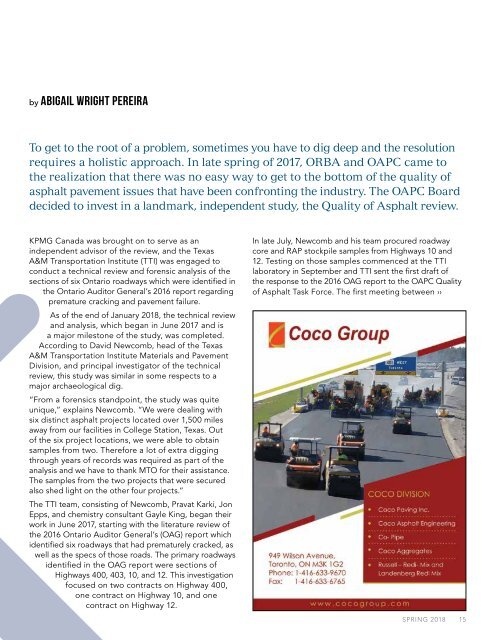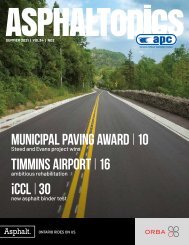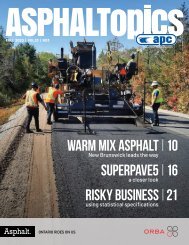ASPHALTopics | Spring 2018 | VOL 31 | NO 1
Create successful ePaper yourself
Turn your PDF publications into a flip-book with our unique Google optimized e-Paper software.
y Abigail Wright Pereira<br />
To get to the root of a problem, sometimes you have to dig deep and the resolution<br />
requires a holistic approach. In late spring of 2017, ORBA and OAPC came to<br />
the realization that there was no easy way to get to the bottom of the quality of<br />
asphalt pavement issues that have been confronting the industry. The OAPC Board<br />
decided to invest in a landmark, independent study, the Quality of Asphalt review.<br />
KPMG Canada was brought on to serve as an<br />
independent advisor of the review, and the Texas<br />
A&M Transportation Institute (TTI) was engaged to<br />
conduct a technical review and forensic analysis of the<br />
sections of six Ontario roadways which were identified in<br />
the Ontario Auditor General’s 2016 report regarding<br />
premature cracking and pavement failure.<br />
As of the end of January <strong>2018</strong>, the technical review<br />
and analysis, which began in June 2017 and is<br />
a major milestone of the study, was completed.<br />
According to David Newcomb, head of the Texas<br />
A&M Transportation Institute Materials and Pavement<br />
Division, and principal investigator of the technical<br />
review, this study was similar in some respects to a<br />
major archaeological dig.<br />
“From a forensics standpoint, the study was quite<br />
unique,” explains Newcomb. “We were dealing with<br />
six distinct asphalt projects located over 1,500 miles<br />
away from our facilities in College Station, Texas. Out<br />
of the six project locations, we were able to obtain<br />
samples from two. Therefore a lot of extra digging<br />
through years of records was required as part of the<br />
analysis and we have to thank MTO for their assistance.<br />
The samples from the two projects that were secured<br />
also shed light on the other four projects.”<br />
The TTI team, consisting of Newcomb, Pravat Karki, Jon<br />
Epps, and chemistry consultant Gayle King, began their<br />
work in June 2017, starting with the literature review of<br />
the 2016 Ontario Auditor General’s (OAG) report which<br />
identified six roadways that had prematurely cracked, as<br />
well as the specs of those roads. The primary roadways<br />
identified in the OAG report were sections of<br />
Highways 400, 403, 10, and 12. This investigation<br />
focused on two contracts on Highway 400,<br />
one contract on Highway 10, and one<br />
contract on Highway 12.<br />
In late July, Newcomb and his team procured roadway<br />
core and RAP stockpile samples from Highways 10 and<br />
12. Testing on those samples commenced at the TTI<br />
laboratory in September and TTI sent the first draft of<br />
the response to the 2016 OAG report to the OAPC Quality<br />
of Asphalt Task Force. The first meeting between ››<br />
SPRING <strong>2018</strong> 15

















